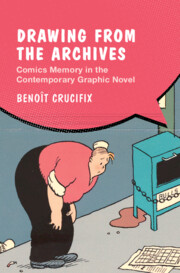55 results
Chapter 8 - The Message of the Medium
- from Part II - Translations
-
-
- Book:
- The Roman Republic and Political Culture
- Published online:
- 30 January 2025
- Print publication:
- 06 February 2025, pp 225-271
-
- Chapter
- Export citation
Chapter 9 - The memoria of the gentes as the Backbone of Collective Memory in Republican Rome
- from Part II - Translations
-
-
- Book:
- The Roman Republic and Political Culture
- Published online:
- 30 January 2025
- Print publication:
- 06 February 2025, pp 272-293
-
- Chapter
- Export citation

Jacobitism and Cultural Memory, 1688–1830
-
- Published online:
- 27 January 2025
- Print publication:
- 13 February 2025
-
- Element
-
- You have access
- Open access
- HTML
- Export citation
3 - The Book of Isaiah and the Neo-Babylonian Period
- from Part I - The Book of Isaiah Through History
-
-
- Book:
- The Cambridge Companion to the Book of Isaiah
- Published online:
- 08 November 2024
- Print publication:
- 21 November 2024, pp 33-48
-
- Chapter
- Export citation
The Biophysical Afterlife of Slavery Signaled through Coral Architectural Stones at Heritage Sites on St. Croix
-
- Journal:
- American Antiquity / Volume 89 / Issue 4 / October 2024
- Published online by Cambridge University Press:
- 03 March 2025, pp. 591-607
- Print publication:
- October 2024
-
- Article
-
- You have access
- Open access
- HTML
- Export citation
Shades of complicity: archives of the ‘implicated subject’
-
- Journal:
- Modern Italy / Volume 29 / Issue 3 / August 2024
- Published online by Cambridge University Press:
- 09 October 2024, pp. 329-344
- Print publication:
- August 2024
-
- Article
-
- You have access
- Open access
- HTML
- Export citation
Disinfecting the Dead, Sanitizing Empire: The Cultural Memory of Fallen Soldiers in Cuba
-
- Journal:
- The Journal of the Gilded Age and Progressive Era / Volume 23 / Issue 3 / July 2024
- Published online by Cambridge University Press:
- 29 October 2024, pp. 336-354
- Print publication:
- July 2024
-
- Article
-
- You have access
- HTML
- Export citation
Gedächtnis trifft Einleitung. Ein neuer Blick auf alte Fragen
-
- Journal:
- New Testament Studies / Volume 70 / Issue 2 / April 2024
- Published online by Cambridge University Press:
- 03 June 2024, pp. 131-148
- Print publication:
- April 2024
-
- Article
-
- You have access
- Open access
- HTML
- Export citation
4 - Rivers and Memory
-
- Book:
- Medieval Riverscapes
- Published online:
- 15 March 2024
- Print publication:
- 28 March 2024, pp 140-172
-
- Chapter
- Export citation
Chapter 14 - Split Selves and Double Consciousness in Recent Irish Fiction
-
-
- Book:
- Race in Irish Literature and Culture
- Published online:
- 04 January 2024
- Print publication:
- 18 January 2024, pp 281-301
-
- Chapter
- Export citation
Communicative remembering: Revisiting a basic mnemonic concept
- Part of
-
- Journal:
- Memory, Mind & Media / Volume 2 / 2023
- Published online by Cambridge University Press:
- 03 January 2024, e9
-
- Article
-
- You have access
- Open access
- HTML
- Export citation
Chapter 1 - Memory and Mirage
-
- Book:
- Sparta and the Commemoration of War
- Published online:
- 08 December 2023
- Print publication:
- 21 December 2023, pp 1-32
-
- Chapter
- Export citation

The Ten Commandments
- Monuments of Memory, Belief, and Interpretation
-
- Published online:
- 20 September 2023
- Print publication:
- 28 September 2023
Chapter 13 - Comics and Their Archives
- from Part III - Uses
-
-
- Book:
- The Cambridge Companion to Comics
- Published online:
- 17 August 2023
- Print publication:
- 31 August 2023, pp 267-286
-
- Chapter
- Export citation
Chapter 6 - Jesting, Nostalgia, and Agonistic Play
- from Part II - The Politics of Memory and Affect
-
-
- Book:
- Memory and Affect in Shakespeare's England
- Published online:
- 07 June 2023
- Print publication:
- 27 July 2023, pp 124-140
-
- Chapter
- Export citation
Chapter 4 - “Gathered again from the ash”
- from Part II - The Politics of Memory and Affect
-
-
- Book:
- Memory and Affect in Shakespeare's England
- Published online:
- 07 June 2023
- Print publication:
- 27 July 2023, pp 89-105
-
- Chapter
- Export citation

Drawing from the Archives
- Comics Memory in the Contemporary Graphic Novel
-
- Published online:
- 06 July 2023
- Print publication:
- 20 July 2023
Chapter 10 - Sulla’s Dictatorship Rei Publicae Constituendae and Roman Republican Cultural Memory
- from Part II - Politicising Cultural Memory
-
-
- Book:
- Cultural Memory in Republican and Augustan Rome
- Published online:
- 27 April 2023
- Print publication:
- 11 May 2023, pp 169-182
-
- Chapter
- Export citation
Chapter 1 - Introduction: What is Cultural Memory?
-
-
- Book:
- Cultural Memory in Republican and Augustan Rome
- Published online:
- 27 April 2023
- Print publication:
- 11 May 2023, pp 1-20
-
- Chapter
- Export citation
Chapter 19 - Exchanging Memories: Coins, Conquest, and Resistance in Roman Iberia
- from Part IV - Locating Cultural Memory
-
-
- Book:
- Cultural Memory in Republican and Augustan Rome
- Published online:
- 27 April 2023
- Print publication:
- 11 May 2023, pp 333-354
-
- Chapter
- Export citation

